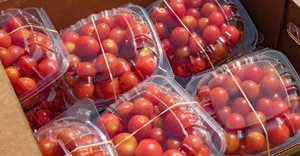Flashfood is a revolutionary service allowing for the reduction of food waste across the United States. In this Q&A, Waste360 meets with the founder and CEO to hear about what makes this program so successful.

In the United States, food is the largest category of waste that is sent to municipal landfills, despite most of it is completely edible. This large waste of food takes up unnecessary space in landfills and hurts the pockets of grocers who have to throw away food after its best-by date.
This can all come to an end with Flashfood.
Flashfood is a service allowing grocers to sell foods past their best-by dates for a discounted price. This allows the grocer to still make a profit from the otherwise wasted food, while also giving consumers an option to buy food at a discount. Additionally, this service eliminated millions of pounds of food.
The founder and CEO of Flashfood, Josh Domingues, is enthusiastic about the deal his company provides for each party involved. In this Q&A with the innovator, Domingues tells Waste360 about the beginnings of Flashfood, what it has already accomplished, and the goals it will soon achieve.
Waste360: Can you tell me the story of how Flashfood began?
Domingues: Flashfood was founded in 2016 after I was inspired by a conversation with my sister, who was working as a caterer at the time.
She called me upset saying that she had just thrown out thousands of dollars of food after an event. It got me thinking about where else food was being wasted.
I began to research and the more I learned about the problem, the more I thought there had to be a way to solve at least a portion of it.
After many months of reading and meeting with people across the supply chain, it became clear that there was a significant opportunity to reduce food waste in grocery stores and to ensure that food ended up on dinner tables, not in landfills.
Grocery stores are left with a surplus of food items that are reaching their best-before date daily, and supply chain challenges in the past few years have only compounded the issue.
The size of the food waste problem is overwhelming.
Grocery stores throw out 133M tons of food every year, which equates to about $37B of lost profits.
A single store location throws out an average of $5k - $10K worth of food every day, and 10 percent of food waste in America happens in supermarkets.
Wasted food is the single biggest category of material placed in municipal landfills in America - most of which is perfectly good food that could have helped feed families in need
The idea became reality once Flashfood received a commitment from one of Canada’s largest grocers to launch it as a pilot program in one of their stores.
The app was simple then, but as the company has grown, so has our product. By partnering with Flashfood, grocery retailers recover costs, reduce shrink, and make a positive impact on their carbon footprint.
Waste360: What are the biggest overarching goals of the company?
Domingues: As grocery prices continue to rise and climate change demands us to move faster, Flashfood’s vision is to reimagine the grocery store as a place where food never goes to waste.
Our goals are aligned with our dual mission of reducing food waste and feeding people more affordably.
First, we’re expanding our footprint across the U.S. to broaden access to healthy food at an affordable price.
Next, Flashfood will work with grocers to make even more food available on the app, providing shoppers with an increased selection, while continuing to deepen our impact on retail food waste, which remains a massive challenge for grocers.
Lastly, we’re working to expand the accessibility of the platform by offering new payment methods, such as SNAP EBT. We’re excited to share more news on that work this fall.
Waste360: What is the current target Flashfood is aiming for?
Domingues: In September, we were thrilled to announce that we have diverted more than 50 million pounds of food waste, enough to feed a stadium full of fans for more than three solid months.
We’ve now set our sights even higher, and 100 million pounds can’t come soon enough.
Flashfood’s mission is to reduce the environmental impact of food waste while feeding families more affordably. Ultimately, we have ambitions to carry out our mission on a global scale.
Flashfood is currently available in the following states: DE, FL, IA, IL, IN, KY, MA, MD, MI, NE, NY, OH, PA, RI, VA, WI, and WV.
The platform will meaningfully expand across 300+ locations in the Northeast this fall, with plans to double our U.S. footprint in 2023.
In addition to expanding Flashfood’s footprint through new grocers and other strategic partnerships, Flashfood is also investing in its technology to make the marketplace accessible to a broader base of consumers, by adding new payment methods like SNAP/EBT.
Waste360: How does the model of Flashfood work?
Domingues: For Shoppers, Flashfood helps feed families affordably by connecting consumers to nearby grocery stores offering up to 50% savings on nutritious food nearing its best-by date.
The platform gives shoppers access to fresh and healthy groceries at an affordable price, making it a helpful option for households facing rising grocery prices.
By downloading the Flashfood app, shoppers simply find a nearby participating grocery location, choose discounted food items, and complete their purchase directly on the app.
Consumers conveniently pick up their orders at the designated Flashfood Zone at their local grocery store.
The app shows real-time metrics for pounds of food waste diverted and the number of driving emissions saved on our shoppers’ accounts, so they can see how quickly their actions add up.
For Grocers, Flashfood is a digital solution for grocery retailers to sell surplus food, reduce shrink, bring in new customers, and lower their carbon footprint.
As grocers invest more in sustainability programs, Flashfood is an innovative solution that saves retailers money while helping the environment.
Grocery operators are extremely skilled at their trade and integrating Flashfood into their existing Standard Operating Procedures (SOPs) is seamless.
There are no hefty costs, time investment, or integrations required to partner with Flashfood.
After front-line grocery staff in each department (meat, produce, bakery, etc.) scan items out of inventory, they simply post the surplus food to Flashfood.
Shoppers search and purchase directly through the Flashfood app and Flashfood manages the transactions. Once a transaction is completed, shoppers head to the Customer Service area at their Flashfood pick-up location and collect their items.
Shoppers usually purchase full-price items while picking up their Flashfood orders, resulting in new customers and additional revenues for participating grocers.
Waste360: How did Flashfood manage to secure the $12.3 million in Series A funding?
Domingues: Flashfood operates a thriving marketplace coast-to-coast in Canada and has experienced significant growth since launching in the U.S.
Over the past year, Flashfood has grown over 300%+ in the Northeast and Midwest, with its growth further accelerating in the past few months.
The platform continues to see increasing demand from consumers, driven by word of mouth and rising grocery bills due to the impact of inflation.
Grocers are increasingly concerned with sustainability. As sustainability targets take on more importance for retail operators, Flashfood is seeing more inbound demand from America’s top grocery chains.
Grocers are hungry for new solutions to reduce waste and their operation’s carbon footprint and Flashfood is able to help solve those problems, while also helping families to eat healthier and more affordable.
Flashfood announced its Series A funding round in February 2022, led by investment partner Chuck Templeton from S2G Ventures.
Chuck was the founder of OpenTable and the founding Chairman of Grubhub.
Follow-on investment came from existing investors General Catalyst, Food Retail Ventures, Rob Gierkink, and Alex Moorhead, as well as new investor, ArcTern Ventures.
Waste360: What will the funding be going towards specifically within the company?
Domingues: The funding will support Flashfood’s continued expansion in the U.S., enhancing the company’s ability to feed more families affordably by working with retailers to sell food that would typically be discarded.
Waste360: What are the company’s goals for the end of the year?
Domingues: The following list encapsulates the company’s current goals;
Expand Flashfood’s footprint across grocery stores in the U.S., with emphasis on growth from coast-to-coast.
Work with existing grocers to make even more food available on the app, deepening the impact on in-store waste.
Broaden access to the platform by offering more accessible payment methods like SNAP/EBT
Continue increasing Flashfood’s impact on the global food waste problem - Flashfood just hit an incredible milestone of 50 million pounds of food diverted from landfills – the next 50 million can’t come soon enough!
Waste360: How much food waste is this app responsible for diverting?
Domingues: To date, Flashfood has diverted 50 million pounds of food diverted from landfills, preventing 95 million pounds of carbon dioxide equivalent (CO2e) from entering the atmosphere. That’s the equivalent of eliminating over 38,000 transatlantic flights.
Rather than ending up in landfills, all those Flashfood purchases fed the equivalent of an entire sports stadium, filled with fans, for more than three months.
Waste360: Are there any other exciting milestone accomplishments you would like to share?
Domingues: The app has saved shoppers over $120M on their grocery bills since the company was founded and consistent Flashfood shoppers save more than $540 per year on average.
Waste360: What are the next steps toward achieving company goals?
Domingues: Expanding Flashfood’s store footprint is a key lever to increasing its impact on communities affected by rising food prices while deepening its environmental impact.
In July, Flashfood announced its expansion to all Giant Eagle locations, adding 140 new stores to the app in Ohio and Pennsylvania.
Flashfood will be available in an additional 300 locations in the Northeast this fall, including New York City’s five boroughs, with details soon to be announced.
Waste360: Is this anything else you would like to share?
Domingues: Flashfood is available to everyone in communities with participating stores, but shoppers are typically on a limited budget, trying to make ends meet - they’re primary shoppers for busy households, retirees, and students.
Although 1 in 5 Flashfood shoppers experience food insecurity, most are working adults, looking for ways to reduce their grocery bills
Flashfood’s shoppers have two things in common: they love a good deal & love that their purchases are making a positive impact on the planet.
According to a Flashfood Shopper Insights Survey, more than 80% of shoppers reported that it is somewhat or very important to them that their Flashfood purchases reduce retail food waste.
Additional metrics:
80 percent of Flashfood's shoppers are women, of those, most are aged 35 - 64.
Despite being a mobile app, 22 percent of users are retirees and more than 60 percent of all users are over 45.
Although most Flashfood users are employed full or part-time, 16percent are living below the poverty line.
1 in 4 Flashfood shoppers manages a health condition that requires a special diet.
Flashfood is in more than 1,450 supermarkets across the U.S. and Canada including GIANT, Giant Eagle, Giant Food, Family Fare, Martin’s Markets, VG’s, Meijer, Stop & Shop, Tops Friendly Markets, Food Lion, Hy-Vee, IGA, and Loblaw Co. (Real Canadian Superstore, Maxi, Provigo, Dominion, Wholesale Club, Atlantic Superstore, Wholesale Club, Zehr’s, No Frills, Loblaws, and Independent).
Flashfood just launched its first location in New York City’s five boroughs with Stop & Shop in the Bronx and is expanding to its other locations in the area later this fall.
About the Author(s)
You May Also Like




